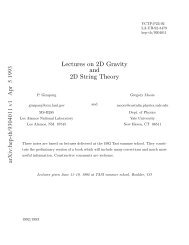Brock Biology of Microorganisms
Brock Biology of Microorganisms
Brock Biology of Microorganisms
Create successful ePaper yourself
Turn your PDF publications into a flip-book with our unique Google optimized e-Paper software.
Figure 12.22 Neisseria and Chromobacterium.<br />
(a) TM electron micrograph <strong>of</strong> Neisseria gonorrhoeae<br />
- typical diplococcus cell arrangements<br />
(b) A large colony <strong>of</strong> Chromobacterium violaceum.<br />
The purple pigment - aromatic compound called violacein.<br />
12.11 ENTERIC BACTERIA p. 351<br />
The enteric bacteria are a large group <strong>of</strong> facultative aerobic rods <strong>of</strong><br />
medical and molecular biological significance.<br />
The phenotypic characteristics used to separate the<br />
enteric bacteria from similar bacteria are focused on<br />
in the Lab class (Table 12.14)<br />
Escherichia O157:H7 vs lab strains (Delhi belly)<br />
Enterobacter common soil bacteria vs. E. coli in water<br />
Shigella – 70% DNA homology to E. coli but ►bacillary dysentery<br />
Salmonella Typhoid fever with > 1,000 serotypes (LPS)<br />
Klebsiella Pneumonia – common in soil – fix nitrogen<br />
Yersinia Plague – rat flea vector. Rats die but also a persistent reservoir<br />
19
















